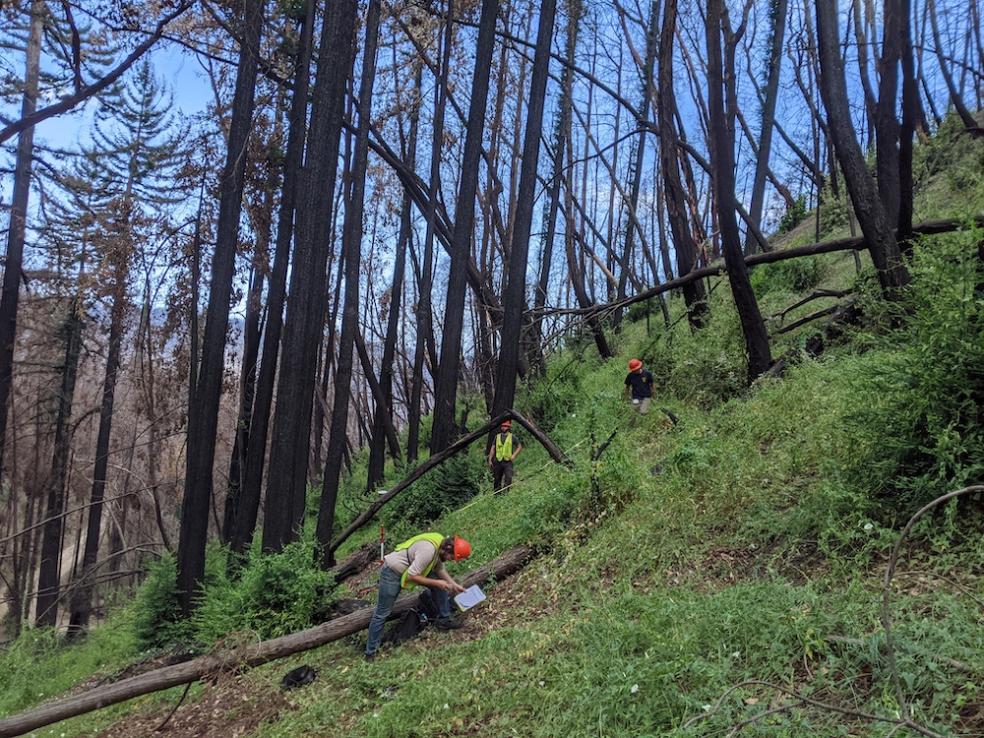
California’s coast redwoods have stood for centuries, weathering a changing climate, logging, and time itself. But in an era of hotter, more frequent wildfires, their future resilience depends on how we care for them, according to new research published in Forest Ecology and Management.
The study sought to understand the effects of wildfire on coast redwoods—the tallest trees in the world. Results revealed that redwoods in second-growth forests largely survived extreme wildfires in 2020 and quickly resprouted from their trunks and bases. Researchers also discovered that forest structure—how dense the trees are and which species are present—strongly influences fire severity, highlighting the importance of management efforts such as thinning, reducing fuel loads, and encouraging fire-resistant species.
“Redwoods are remarkably resilient. But redwood forests are more than just redwoods, and the fires today are not the fires of the past,” says the study’s lead author, Jeff Kane, professor of Fire Ecology & Fuels Management at Cal Poly Humboldt.
Most of today’s redwood forests are second-growth—younger, denser stands that regrew after logging or fire. Mixed with more fire-sensitive species like tanoak and Douglas-fir, these young forests are especially vulnerable to modern high-severity wildfire.
The study, co-authored with graduate student researcher Jackson Carrasco in partnership with Save the Redwoods League, examined three second-growth forest sites along the central California coast that experienced wildfires—the CZU Lightning Complex, Walbridge Fire, and Dolan Fire—in 2020. Kane, Carrasco, and a team of undergraduate students sampled more than 120 plots, measuring canopy loss, resprouting, and tree death to better understand forest recovery.
Data showed that few redwoods died, and those that did were small. That’s a good thing, says Kane, as this natural thinning helps the remaining trees grow stronger and more resilient to future fires. However, some trees lost large portions of their canopies or main trunks, which sets them back decades in growth and can significantly impact wildlife habitat.
"Coast redwoods are a resilient, fire-adapted species, and the results of this study highlight that redwood superpower,” said Laura Lalemand, senior scientist at Save the Redwoods League. “By applying what we’ve learned to future forest restoration efforts, we can aim to moderate future wildfire intensity, minimizing the negative impacts and recovery time for redwood forests.”
“One of the biggest surprises from the study was that the more damage from fire a redwood experienced, the more new shoots and branches formed after the fire,” Kane says. “This shows that redwood forests can recover more quickly than expected after unusually intense fires.”
Researchers also found that the way forests are arranged—how dense they are and which species are present—strongly influences fire severity.
Understanding how fires affect redwoods can help forest managers safeguard both the trees, the rich ecosystems they support, and the human communities that reside among these forests, Kane says.
“We have an opportunity and a responsibility to limit the negative effects of modern wildfires and promote healthier redwood forests,” he adds.
About the Study
The research, titled Tree and stand characteristics moderate wildfire severity and promote resilience in secondary coast redwood forests, was published in Forest Ecology and Management in November 2025. The study examined post-fire conditions at three second-growth redwood forest sites along California's central coast following three 2020 wildfires.
About Cal Poly Humboldt
Cal Poly Humboldt, Northern California’s first polytechnic university, is dedicated to hands-on learning, applied research, and environmental stewardship in the arts and sciences. Surrounded by ancient redwoods and minutes from the Pacific coast, the University serves as a living lab for innovation in sustainability and natural resources. Humboldt is part of the California State University system. Learn more at humboldt.edu.
About Save the Redwoods League
One of the nation’s longest-running conservation organizations, Save the Redwoods League has been protecting and restoring redwood forests since 1918. The League has connected generations of visitors with the beauty and serenity of the redwood forests. Our supporters have enabled the League to protect more than 220,000 acres of irreplaceable forests in 66 state, national, and local parks and reserves. For information, visit SaveTheRedwoods.org.